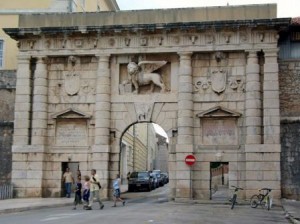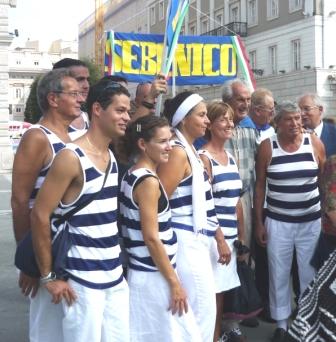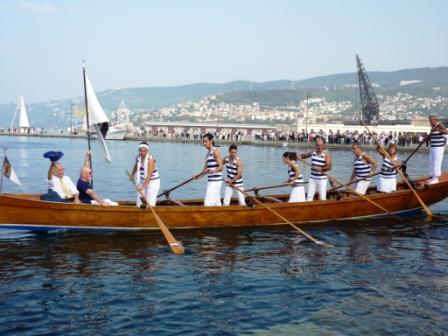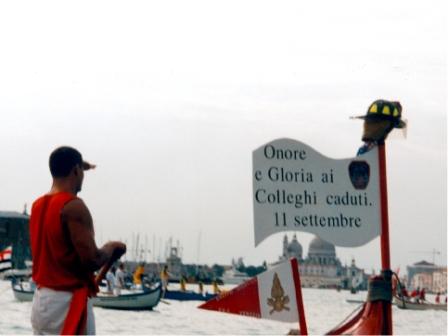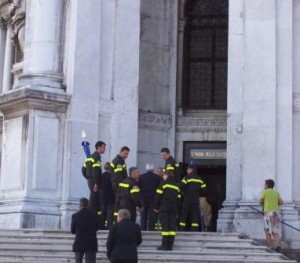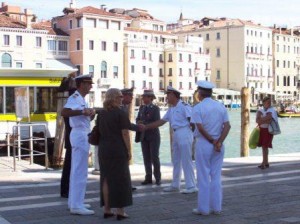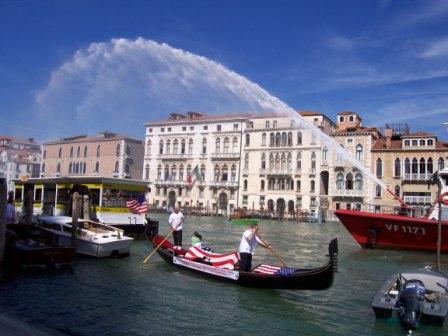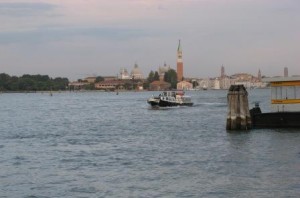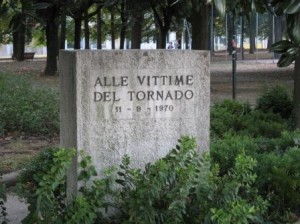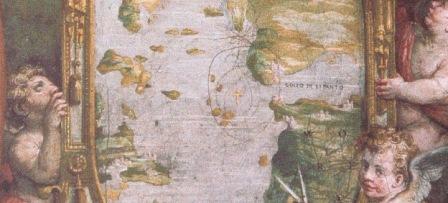

We’re back from our excellent adventure in Greece, and to tell the story in even its most rudimentary form will require a little time and a certain amount of context. I’ll try to keep the pace brisk, but we’ve got a lot of ground to cover. Stragglers will be shot. Deserters also.
Practically every town and village in Greece has its special annual event, but there aren’t many anywhere whose local festa commemorates an event crucial to the history of Europe and, I think one may say, the world.
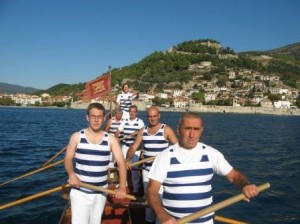
We went, eight of us with the faithful gondolone “San Marco,” to a town called Nafpaktos (NAHF-pak-tos), just inland from Patras on the west coast of Greece, to participate in the annual spectacle which commemorates the victory of the Battle of Lepanto. The Venetians modified the town’s other name, Epaktos, into Lepanto (LEH-pan-to), and this is the name by which the epic naval battle of October 7, 1571 has gone into the annals. Nafpaktos means “place where ships are built,” but judging by its history — eight battles over two millennia — it more likely means “place where ships are blasted to flinders and their crews killed and maimed.”
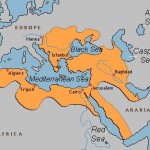
This clash was arguably the most important sea battle to be fought in the 900 years separating the one at Actium and Trafalgar. Why do we say this? Not only on the basis of the numbers involved, but because the battle put an end, once and for all, to the efforts of the Ottoman Turks to conquer the Adriatic and thus open the way for their further expansion into Europe. If the coalition fleet, powerfully bolstered by the Venetian contingent, had lost, Europe would soon have had many more mosques than churches. To put it tactfully.
Let me pause to say to any Turkish partisans out there that I adore Turkey and admire large chunks of its history and culture and would willingly go there at any time for any reason. But when an empire wants to grow — which is a given, considering that once you start an empire, it’s kind of hard to stop until somebody stops it for you– some hideous things can happen. I believe we can all agree on that.
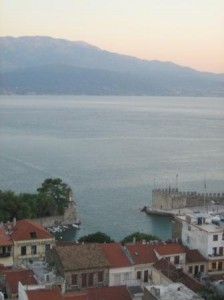
The backstory: Turks and Venetians had been fighting and making up for centuries by the time the fateful year of 1571 arrived. But the situation had become increasingly desperate, as one after another the Ottoman forces conquered many of Venice’s prize possessions in the eastern Mediterranean and moved ever deeper into the Balkans. Then came the appalling siege of Famagosta in Cyprus, which dragged on for ten months between 1570 and 1571, thanks to the bulldog resistance of commander Marcantonio Bragadin who had absolutely no hope of reinforcements. On July 31, 1571, not only was he was finally forced to capitulate, he was then flayed alive and his skin stuffed with straw to make a sort of effigy which was paraded through town on a donkey before being sent as a victory trophy to Sultan Selim II. The humiliation, rage and grief of the Venetians pushed them to the head of the line when the chance for revenge came just two months later at Lepanto.
That, and the fact that there had already been not one, but two, battles at Lepanto (1499 and 1500) with the same cast of characters and plot line, both of which Venice had lost. If history is geography, Lepanto is clearly on one of those strategic power points.
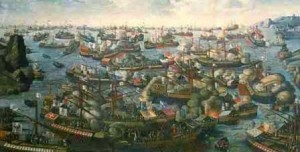
The combatants: The Ottoman fleet, obviously, on the one hand. On the other was the combined forces of The Holy League, organized by Pope Pius V and comprising ships from Spain, Genoa, the Order of St. Stephen (Pisa), assorted towns of Dalmatia, the Knights of Malta, the Papal States, a healthy assortment of Italian noble ruling families (de’ Medici, Gonzaga, Este, Farnese, della Rovere), the dukes of Savoy and of Tuscany and, of course, Venice. The commander in chief was Don John of Austria, who despite being only 25 years old showed himself to be a brilliant tactician. The Venetians, who supplied a good half of all the ships involved, were led by Sebastiano Venier.
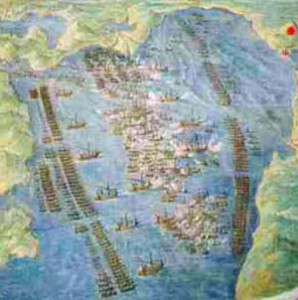
The two fleets engaged at 10:30 AM on October 7, in the waters outside the entrance to what is now called the Gulf of Corinth. The area was near a scattering of islets known as the Curzolari; for this reason the battle is also occasionally (pedantically) referred to as the Battle of the Curzolari.
The numbers involved vary so widely among the many accounts that I’ll just give them all and let you pick the ones you like best.
The League had 284 ships (or 195, or 300) of varying types — half of which were supplied by Venice — carrying 1,185 guns, 12,920 sailors, 43,000 rowers and 28,000 soldiers. The Ottomans had 277 ships but carried only 750 guns and 25,000 soldiers, including 12-15,000 Greeks taken prisoner for this purpose and 2,500 janissaries, the only troops equal to the Spanish infantry.
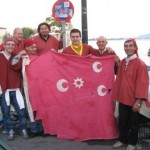
Approximate casualties: Whatever the true totals, the difference between the two sides is obvious.
The Holy League: 7,500 (or 9,000, 12,000, or 15,000) men, 12 (or 15) ships sunk and one captured.
The Ottomans: 30,000 (or 20,000) men, 8,000 taken prisoner, 113 ships sunk and 117 captured, some of which were in good enough condition to be used by the victors. The only prize the Turks snagged was one Venetian galley.
I’ll pause for a second to attempt to imagine what 45,000 casualties look like, especially when they all die in the space of five hours. The attempt has failed. Let’s go on.
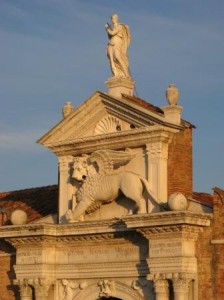
Meanwhile, at Venice, the campanile of San Marco was being manned continually by lookouts awaiting some sign of the battle’s outcome. The Venetians sent word by their fastest galley, the Angelo, which entered the lagoon ten days later, on October 18. The instant that the lookout could make out that the ship was draped with Turkish flags, he cried “Victory!”
Every bell in the city began to ring. Total strangers kissed each other in the streets. Shops closed in celebration, some owners slapping signs on the doors saying “Closed due to the death of the Turks.” The debtors’ prison was emptied. Permission to wear masks was given. And so on and on. A triumphal arch was constructed over the entrance to the Arsenal, and every year on October 7 (feast-day of Santa Giustina), from 1572 till the fall of the Republic in 1797, the Doge and the government would go in procession to the church of Santa Giustina, where the captured Turkish standards were brought out for all to see.

Another trophy — if one can call it that — of the war was Miguel Cervantes’s left hand. He fought at Lepanto aboard the ship Marquesa, and when another writer later derided him as being “old and one-handed,” he replied: “What I cannot help taking amiss is that he charges me with being old and one-handed, as if it had been in my power to keep time from passing over me, or as if the loss of my hand had been brought about in some tavern, and not on the grandest occasion the past or present has seen, or the future can hope to see. If my wounds have no beauty in the beholder’s eye, they are, at least, honourable in the estimation of those who know where they were received….”
So who were the real victors? Morale soared on the European side: It had finally been shown that the Ottomans could be defeated, something which after about 100 years had begun to appear unlikely. On the other hand, Venice never got Cyprus back. And although it was wonderful that they had destroyed the Turkish navy, it was back to its previous strength within a year.
“I would have you know the difference between your loss and ours,” the Grand Vizier Sokullu Mehmet Pasha told the Venetian emissary. “In wresting Cyprus from you, we deprived you of an arm; in defeating our fleet, you have only shaved our beard. An arm when cut off cannot grow again, but a shorn beard will grow all the better for the razor.”
All true. But the Ottomans never succeeded in conquering the Adriatic, which would have jammed the door open to many unhappy events. I consider that to be the verdict on Lepanto, and so did most of the delirious victors.
Let’s move up to last week. For the third year in a row, we were invited to participate in an hour-long show broadcast live on Greek television commemorating this event. Obviously nothing anyone can do today could match the event itself, so it came down to a kind of audio-visual creation heavy on symbolism (I think that’s what it was) and mood. And fireworks. You can never go wrong there.
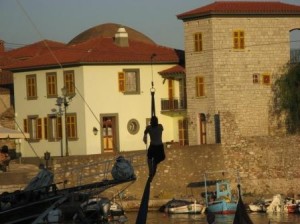
Our assignment was to row around the tiny fortified harbor, providing a Venetian/nautical tinge while all sorts of things were happening around us: Strobe lights and projections on the stone walls enclosing the port, acrobats climbing long strips of fabric and creating dramatic human shadows that moved sort of like combatants, a procession of costumed Venetians from C.E.R.S., flames shooting from the battlements, as well as from a Croatian two-masted ship which also poured white fireworks into the sea, and finally, an acrobat in a white bodysuit suspended over the water who danced to a melancholy song which even though it was in Italian, I couldn’t understand. (Our material contribution was to carry the girl and her assistant to and from the point of performance.) Coming at the end, her silent contortions gave an elegiac quality to the event, which was almost immediately canceled out by the fireworks that followed.
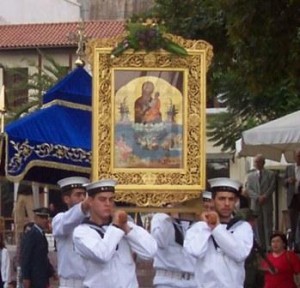
Entertaining as this was (and I have to say that the editions of 2008 and 2007 were much more elaborate and imaginative — evidently the economic crisis has bitten deep into the budget here), for me the much more important and moving ceremony occurred the following morning.
After a long commemorative Orthodox mass in the cathedral, a procession formed to march to the harbor: An armed honor guard and military band, a few bishops and other clergy and a large icon of the Madonna (who is credited, much more than Santa Giustina, for the victory), the mayor and city councilors, and representatives from most of the nations which contributed to the battle.
After a short speech by the mayor, and a series of prayers by the bishop, a moment of silence was called. I know this because suddenly a silence fell on the harbor and everyone in it which was something exceptional. This silence wasn’t just the absence of noise, it was as if the world had literally stopped. Whether you wanted to or not, your thoughts (mine, I mean) had to go straight to the battle and especially its victims, among whom I willingly remember the Turks, who naturally did not send a representative even though their troops were just as dead as ours.

Then each nation’s official took a laurel wreath — I counted ten — and one by one, tossed it into the water. Last year this segment was enriched by a cannon blast before each one and the playing of that country’s national anthem by the military band, which I found tremendously affecting. This year, no cannon, and evidently not only money but even time was in short supply because after this brisk sequence the ceremony closed with only one piece of music, the Greek national anthem. We, as always, raised our oars in acknowledgment of the prayers and the anthem.
I’m not going to risk attempting to close with some profound summary. All you have to do is consider even the barest outlines of the conflict and then, as Job admonished his friends, “Be astonished, and lay your hand upon your mouth.”
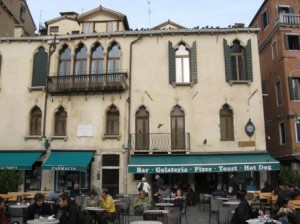
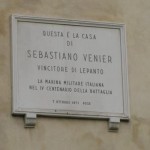

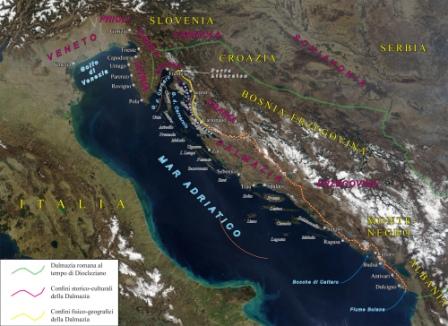
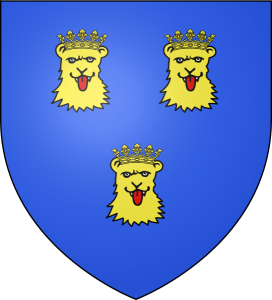 nd so a group was formed, the Association of the Dalmatians in the World, under the flag of Dalmatia, language, and unfathomable store of historic culture and personal memories. (This is one of some 30 Dalmatian heritage/cultural/ political groups in Italy alone). This group has a huge reunion every year, and this year it was held at Trieste from September 14-20, AND, the faithful gondolone of our rowing club, the Canottieri Diadora, was invited to participate in the festivities. So off we all went to Trieste for a beautiful weekend which involved listening to speeches, a concert (did you know that Franz von Suppe’ was Dalmatian? Remember that the next time you hear “The Light Cavalry Overture”), eating, drinking, some walking around, and about a half-hour of rowing. It was great.
nd so a group was formed, the Association of the Dalmatians in the World, under the flag of Dalmatia, language, and unfathomable store of historic culture and personal memories. (This is one of some 30 Dalmatian heritage/cultural/ political groups in Italy alone). This group has a huge reunion every year, and this year it was held at Trieste from September 14-20, AND, the faithful gondolone of our rowing club, the Canottieri Diadora, was invited to participate in the festivities. So off we all went to Trieste for a beautiful weekend which involved listening to speeches, a concert (did you know that Franz von Suppe’ was Dalmatian? Remember that the next time you hear “The Light Cavalry Overture”), eating, drinking, some walking around, and about a half-hour of rowing. It was great.